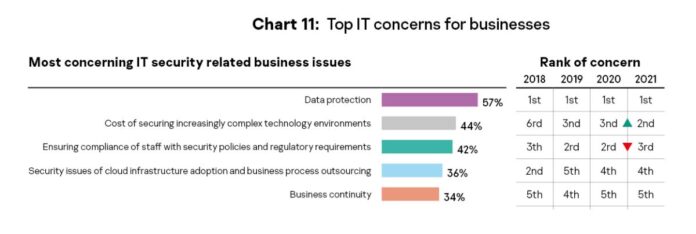The cost of securing increasingly complex environments has soared to second place in the top challenges IT leaders say their businesses are facing in 2021. That is up from third place last year and sixth place in 2018, according to the latest Kaspersky ‘IT Security Economics’ report. With digitalization, remote work, and cloud usage growth, this complexity may impact organizations’ visibility of threats and incident response.
2020 saw lockdowns and remote work stimulate the use of digital technologies in businesses. According to a study by McKinsey & Company, companies have accelerated the digitization of their customer and supply-chain interactions along with the share of digital or digitally-enabled products in their portfolios. This required massive adoption of new IT services and changes to IT infrastructure.
Businesses had to ensure the safety of all these innovations, which became a real challenge for almost half of all companies (44%). Only data protection was higher — the concern that has stayed in first place for several years already. The cost of securing complex environments turned out to be even more crucial than ensuring compliance with security policies which stayed in second place for the last two years.
Cloud adoption has also contributed to IT infrastructure complexity. According to Kaspersky’s study, in 2020-2021, the use of all types of cloud, including public and private ones, has grown to 88%, compared with only 72% in 2019. In addition, virtual desktop infrastructure, which should have helped companies organize remote access to corporate workspaces to work safely from home, increased from 82% to 86%.
The problem with complex environments is not only that it is difficult to roll out security tools. It makes it much more difficult to track down the signs of an attack and respond to it in a timely way to minimize the possible damage. In fact, lack of visibility over the infrastructure is the most common challenge (41%) organizations face when dealing with complex threats.
Fortunately, the issue stimulates investment. Almost half (47%) of enterprises named the increased complexity of their IT infrastructure as the top reason to increase their IT security budget (compared to 43% in 2020).
“When it comes to corporate cybersecurity, the matter is not only related to ever-evolving threats. A heterogeneous and constantly changing corporate IT infrastructure further increases the stakes. On one hand, it complicates the very process of protection; on the other, the consequences of a successful attack may be much more difficult to address. Fortunately, the cybersecurity industry doesn’t standstill. The most up-to-date threat intelligence and solutions for detection and response should help organizations undertake the challenge and embrace any innovations for their business growth,” says Sergey Martsynkyan, VP-corporate product marketing at Kaspersky.
To protect complex environments, with cloud and on-premises workloads, VDI (Virtual Desktop Infrastructure), and remote workforce, organizations should look for a solution with strong detection and response capabilities. The solution should give visibility of threats in any endpoint with background information about malicious activity and options for response actions. Kaspersky Hybrid Cloud Security — which includes updated Kaspersky Security for Virtualization Light Agent, dedicated to the protection of virtualized environments and VDI — now integrates with Kaspersky Endpoint Detection and Response Optimum, Kaspersky Sandbox, and Kaspersky Anti Targeted Attack Platform. Together with endpoint security, they ensure essential protection for the infrastructure of any complexity.
To learn more about Kaspersky Hybrid Cloud Security, please visit the Kaspersky website.
More insights from IT Security Economics 2021: Managing the trend of growing IT complexity can be found here.
